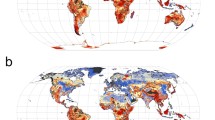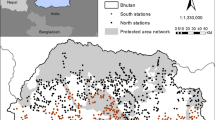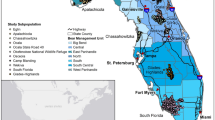Abstract
We conducted a prioritization exercise for 47 terrestrial carnivores in North and Central America. We used 2 by 2 degree cells to explore the spatial patterns in overall richness, regionally endemic and threatened species and identified the hotspots (the top 10% of cells in each category). We obtained optimal minimum sets of cells to represent each carnivore either (1) at least once, (2) three times, or (3) in at least 10% of its regional distribution range. Our analysis considered cells with 50% or more of their area protected, and considered human population density (HPD) per grid cell, excluding the top 10% cells with higher HPD. We found low congruence among hotspots, suggesting these should not be used alone in directing conservation strategies. About 7, 18 and 84 grid cells are needed to reach each representation goal, respectively. A much higher number of protected cells are needed to achieve the same goals. Representing 10% of each species’ distribution range required optimal sets of 47 additional cells to complement the protected cells. Irreplaceable cells had a similar or higher HPD than average values for all cells. By excluding the top 10% of cells with higher HPD, irreplaceable cells in optimal sets had much lower average HPD, but three species cannot be represented at all. By defining conservation priorities and proposing optimal networks of areas needed to represent all carnivores in the region, actual conservation efforts can be reviewed and revised. Furthermore, if our results are incorporated into a general strategy, limited resources available to conserve carnivores might be directed more efficiently.







Similar content being viewed by others
References
Amstrup SC (2000) Polar bear. In: Truett JC, Johnson SR (eds) Natural history of an arctic oil field: development and the biota. Academic Press, San Diego, pp 133–157
Araújo MB, Rahbek C (2007) Conserving biodiversity in a world of conflicts. J Biogeogr 34:199–200
Araújo MB, Williams PH, Turner A (2002) A sequential approach to minimise threats within selected conservation areas. Biodivers Conserv 6:1011–1024
Arita HT, Rodríguez-Tapia G (2004) Patrones geográficos de diversidad de los mamíferos terrestres de América del Norte. Instituto de Ecología, UNAM. Base de datos SNIB-CONABIO proyecto Q068. México
Arita HT, Figueroa F, Frisch A, Rodríguez P, Santos-del-Prado K (1997) Geographical range size and the conservation of Mexican mammals. Conserv Biol 11:92–100
Balmford A (2002) Selecting sites for conservation. In: Norris K, Pain DJ (eds) Conserving bird biodiversity. General principles and their application. Cambridge University Press, Cambridge, pp 74–104
Balmford A, Gaston KJ, Rodrigues ASL, James A (2000) Integrating costs of conservation into international priority setting. Conserv Biol 14:597–605
Brandon K, Gorenflo LJ, Rodrigues ASL, Waller RW (2005) Reconciling biodiversity conservation, people, protected areas, and agricultural suitability in Mexico. World Dev 33:1403–1418
Brashares JS, Arcese P, Sam MK (2001) Human demography and reserve size predict wildlife extinction in West Africa. Proc R Soc Lond B 268:2473–2478
Berger KM (2006) Carnivore-livestock conflicts: effects of subsidized predator control and economic correlates on the sheep industry. Conserv Biol 20:751–761
Bonn A, Gaston KJ (2005) Capturing biodiversity: selecting priority areas for conservation using different criteria. Biodivers Conserv 14:1083–1100
Bonn A, Rodrigues ASL, Gaston KJ (2002) Threatened and endemic species: are they good indicators of patterns of biodiversity on an national scale? Ecol Lett 5:733–741
Briers R (2002) Incorporating connectivity into reserve selection procedures. Biol Conserv 103:77–83
Carbone C, Mace GM, Roberts SC, Macdonald DW (1999) Energetic constraints on the diet of terrestrial carnivores. Nature 402:286–288
Cardillo M, Purvis A, Sechrest W, Gittleman JL, Bielby J, Mace GM (2004) Human population density and extinction risk in the world’s carnivores. PLoS Biol 2:909–914
Carwardine J, Rochester WA, Richardson KS, Williams KJ, Pressey RL, Possingham HP (2006) Conservation planning with irreplaceability: does the method matter? Biodivers Conserv 16:245–258
Ceballos G, Brown JH (1995) Global patterns of mammalian diversity, endemism and endangerment. Conserv Biol 9:559–568
Ceballos G, Ehrlich PR (2006) Global mammal distributions, biodiversity hotspots, and conservation. PNAS 103:19374–19379
Ceballos G, Navarro D (1991) Diversity and conservation of Mexican mammals. In: Mares MA, Schmidly DJ (eds) Latin American mammalogy. History, biodiversity, and conservation. University of Oklahoma Press, Norman, pp 167–197, 468 pp
Ceballos G, Ehrlich PR, Soberón J, Salazar I, Fay JP (2005) Global mammal conservation: what must we manage? Science 309:603–607
Center for International Earth Science Information Network (CIESIN), Columbia University; and Centro Internacional de Agricultura Tropical (CIAT). (2005) Gridded Population of the World Version 3 (GPWv3). Socioeconomic Data and Applications Center (SEDAC), Columbia University, Palisades. Available at http://sedac.ciesin.columbia.edu/gpw. (Downloaded January 10, 2007)
Csuti B, Polasky S, Williams PH, Pressey RL, Camm JD, Kershaw M, Kiester AR, Downs B, Hamilton R, Huso M, Sahr K (1997) A comparison of reserve selection algorithms using data on terrestrial vertebrates in Oregon. Biol Conserv 80:83–97
Crooks KR (2002) Relative sensitivities of mammalian carnivores to habitat fragmentation. Conserv Biol 16:488–502
DeMaster DP, Stirling I (1981) Ursus maritimus. Mamm Species 145:1–7
[ESRI] Environmental Systems Research Institute (2000) ArcView GIS 3.2. software. Redlands
Ferguson SH, Larivière S (2002) Can comparing life histories help conserve carnivores? Anim Conserv 5:1–12
Gaston KJ, Pressey RL, Margules CR (2002) Persistence and vulnerability: retaining biodiversity in the landscape and in protected areas. J Biosci 27:361–384
Ginsberg JR (1999) Global conservation priorities. Conserv Biol 13:5
Ginsberg JR (2001) Setting priorities for carnivore conservation: what makes carnivores different? In: Gittleman JL, Funk S, Macdonald, DW, Wayne RK (eds) Carnivore conservation. Cambridge University Press, pp 498–523
Gittleman JL, Funk S, Macdonald DW, Wayne RK (eds) (2001) Carnivore conservation. Cambridge University Press
Glatston AR (compilator) (1994) The Red Panda, Olingos, Coatis, Raccoons, and their relatives. Status survey and conservation action plan for procyonids and ailurids. (In English and Spanish). IUCN/SSC Mustelid, Viverrid, and Procyonid Specialist Group. 103 pp
Grenyer R, Orme CD, Jackson SF, Thomas GH, Davies RG, Davies TJ, Jones KE, Olson VA, Ridgely RS, Rasmussen PC, Ding TS, Bennett PM, Blackburn TM, Gaston KJ, Gittleman JL, Owens IP (2006) Global distribution and conservation of rare and threatened vertebrates. Nature 444:93–96
Grill A, Crnjar R, Casula P, Menken S (2002) Applying the IUCN threat categories to island endemics: Sardinian butterflies (Italy). J Nature Conserv 10:51–60
Harcourt AH, Parks SA, Woodroffe R (2001) Human density as an influence on species/area relationships: double jeopardy for small African reserves? Biodivers Conserv 10:1011–1026
ILOG (2001) CPLEX 7.1. ILOG, Gentilly
IUCN (2006) 2006 IUCN red list of threatened species. http://www.iucnredlist.org. Downloaded on 14 January 2007
Justus J, Sarkar S (2002) The principle of complementarity in the design of reserve networks to conserve biodiversity: a preliminary history. J Biosci 27:21–43
Laliberte AS, Ripple WJ (2004) Range contractions of North American carnivores and ungulates. Bioscience 54:123–138
Larsen FW, Rahbek C (2003) Influence of scale on conservation priority setting––a test on African mammals. Biodivers Conserv 12:599-614
Linnell JD, Andersen R, Kvam T, Andren H, Liberg O, Odden J, Moa PF (2001) Home range size and choice of management strategy for Lynx in Scandinavia. Environ Manage 27:869–879
Luck GW, Ricketts TH, Daily GC, Imhoff M (2004) Alleviating spatial conflict between people and biodiversity. PNAS 101:182–186
Mace G,Collar NJ (2002) Priority setting in species conservation. In: Norris K, Pain DJ (eds) Conserving bird biodiversity: General principles and their application. Cambridge University Press, pp 61–73
Mace G, Possingham HP, Leader-Williams N (2007) Prioritizing choices in conservation. In: Macdonald DW, Service K (eds) Key topics in conservation biology. Blackwell Publishing, pp 17–34
Margules CR, Pressey RL (2000) Systematic conservation planning. Nature 405:243–253
Margules CR, Pressey RL, Williams PH (2002) Representing biodiversity: data and procedures for identifying priority areas for conservation. J Biosci 27:309–326
Medellín RA, Chetkiewicz C, Rabinowitz A, Redford KH, Robinson JG, Sanderson E, Taber A (eds) (2002) El Jaguar en el nuevo milenio. Una evaluación de su estado, detección de prioridades y recomendaciones para la conservación de los jaguares en Ámerica. Universidad Nacional Autónoma de México/Wildlife Conservation Society, México, 647 pp
Mills MGL, Freitag S, van Jaarsveld AS (2001) Geographic priorities for carnivore conservation in Africa. In: Gittleman JL, Funk S, Macdonald DW, Wayne RK (eds) Carnivore conservation. Cambridge University Press, pp 467–483
Moore JL, Folkmann M, Balmford A, Brooks T, Burgess N, Rahbek C, Williams PH, Karup J (2003) Heuristic and optimal solutions for set-covering problems in conservation biology. Ecography 26:595–601
Noss RF, Quigley HB, Hornocker MG, Merrill T, Paquet C (1996) Conservation biology and carnivore conservation in the rocky mountains. Conserv Biol 10(4):949–963
Nowell K, Jackson P (compilators) (1996) Wild cats: status survey and conservation action plan. IUCN/SSC Cat Specialist Group: 1996, 406 pp
Ogada MO, Woodroffe R, Oguge NO, Frank LG (2003) Limiting depredation by African carnivores: the role of livestock husbandry. Conserv Biol 17:1521–1530
Olson DM, Dinerstein E, Wikramanayake ED, Burgess ND, Powell GVN, Underwood EC, D’amico JA, Itoua I, Strand HE, Morrison JC, Loucks CJ, Allnutt TF, Ricketts TH, Kura Y, Lamoreux JF, Wettengel WW, Hedao P, Kassem KR (2001) Terrestrial ecoregions of the world: a new map of life on earth. BioScience 51:933–938
Parks SA, Harcourt AH (2002) Reserve size, local human density, and mammalian extinctions in U.S. protected areas. Conserv Biol 16:800–808
Pressey RL (1994) Ad hoc reservations: forward or backward steps in developing representative reserve systems? Conserv Biol 8:662–668
Pressey RL, Possingham HP, Margules CR (1996) Optimality in reserve selection algorithms: when does it matter and how much? Biol Conserv 76: 259–267
Pressey RL, Possingham HP, Day JR (1997) Effectiveness of alternative heuristic algorithms for identifying indicative minimum requirements for conservation reserves. Biol Conserv 80:207–219
Purvis A, Mace G, Gittleman JL (2001) Past and future carnivore extinctions: a phylogenetic perspective. In: Gittleman JL, Funk S, Macdonald DW, Wayne RK (eds) Carnivore conservation. Cambridge University Press, pp 11–34
Rodrigues A, Gaston KJ (2002) Optimization in reserve selection procedures––why not? Biol Conserv 107:123–129
Rodrigues ASL, Orestes Cerdeira J, Gaston KJ (2000) Flexibility, efficiency, and accountability: adapting reserve selection algorithms to more complex conservation problems. Ecography 23:565–574
Rondinini C, Stuart S, Boitani L (2005) Habitat suitability models and the shortfall in conservation planning for African vertebrates. Conserv Biol 19:1488–1497
Sanderson EW, Redford KH, Chetkiewicz Ch-LB, Medellin R, Rabinowitz AR, Robinson JG, Taber AB (2002) Planning to Save a Species: the Jaguar as a Model. Conserv Biol 16:58–72
Sarkar S, Pressey RL, Faith DP, Margules CR, Fuller T, Stoms DM, Moffett A, Wilson KA, Williams KJ, Williams PH, Andelman S (2006) Biodiversity conservation planning tools: present status and challenges for the future. Annu Rev Envir Res 31:123–159
Servheen C, Herrero H, Peyton B (compilers) (1998) Bears: status survey and conservation action plan. IUCN/SSC Bear and Polar Bear Specialist Groups. x+306 pp
Sillero-Zubiri C, Hoffmann M, Macdonald DW (eds) (2004) Canids: foxes, wolves, jackals and dogs. Status survey and conservation action plan, IUCN/SSC Canid Specialist Group. Gland
Sillero-Zubiri C, Sukumar R, Treves A (2007) Living with wildlife: the roots of conflict and the solutions. In: Macdonald DW, Service K (eds) Key topics in conservation biology. Blackwell Publishing, pp 255–272
Treves A, Karanth KU (2003) Human-carnivore conflict and perspectives on carnivore management worldwide. Conserv Biol 17:1491–1499
Underhill LG (1994) Optimal and suboptimal reserve selection algorithms. Biol Conserv 70:85–87
UNEP-WCMC (2006). 2006 World Database on Protected Areas. World Conservation Union (IUCN) and UNEP-World Conservation Monitoring Centre (UNEP-WCMC). Downloaded from http://sea.unep-wcmc.org/wdpa/index.htm on January 16, 2007
US Census Bureau (2006) International Data Base (IDB). Available from: http://www.census.gov/ipc/www/idbnew.html. Accessed February 2006
Vázquez LB, Gaston KJ (2006) People and mammals in México: conservation conflicts at a national scale. Biodivers Conserv 15:2397–2414
Wilson DE, Reeder DM (eds) (1993) Mammal species of the world. Smithsonian Institution Press, 1206 pp
Wilting A, Fischer F, Abu Bakar S, Linsenmair KE (2006) Clouded leopards, the secretive top-carnivore of South-East Asian rainforests: their distribution, status and conservation needs in Sabah, Malaysia. BMC Ecology 6(16). doi: 10.1186/1472-6785-6-16
Weber W, Rabinowitz A (1996) A global perspective on large carnivore conservation. Conserv Biol 10:1046–1054
Woodroffe R (2000) Predators and people: using human densities to interpret carnivore declines. Anim Conserv 3:165–173
Woodroffe R, Ginsberg JR (1998) Edge effects and the extinction of populations inside protected areas. Science 280:2126–2128
World Atlas (2006) All countries of the world by land area US. Available from: http://worldatlas.com/aatlas/populations/ctyareal.htm. Accessed February 2006
Acknowledgements
We thank technical support of G. Rodríguez and L.B. Vazquez, from Laboratorio de Macroecología, Instituto de Ecología, UNAM and Biodiversity and Macroecology Group, University of Sheffield, respectively. Compilation of the database of mammalian species used was funded by CONABIO, México. Part of the present analysis was supported through financial support received by D.V.G. from the Royal Society of London and Academia Mexicana de Ciencias to do a short research visit at the WildCRU, University of Oxford. We thank friends and colleagues from CEAMISH-UAEM, Instituto de Ecología-UNAM and WildCRU-University of Oxford who made useful suggestions.
Author information
Authors and Affiliations
Corresponding author
Rights and permissions
About this article
Cite this article
Valenzuela-Galván, D., Arita, H.T. & Macdonald, D.W. Conservation priorities for carnivores considering protected natural areas and human population density. Biodivers Conserv 17, 539–558 (2008). https://doi.org/10.1007/s10531-007-9269-0
Received:
Accepted:
Published:
Issue Date:
DOI: https://doi.org/10.1007/s10531-007-9269-0




